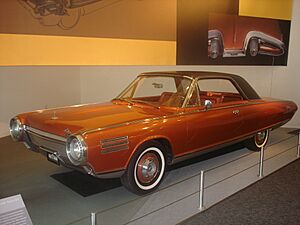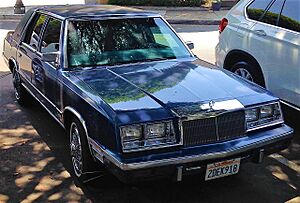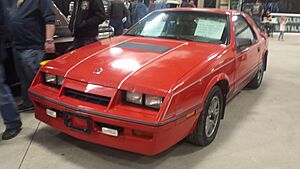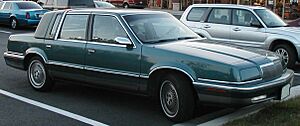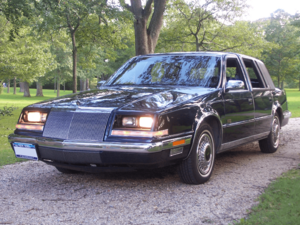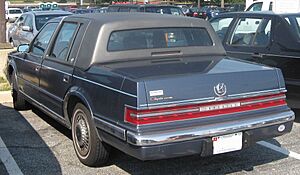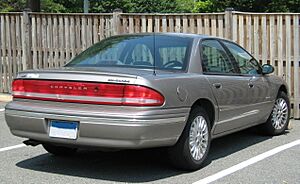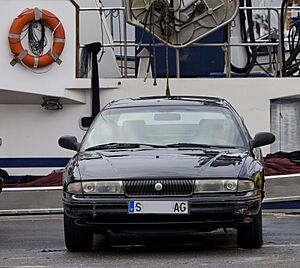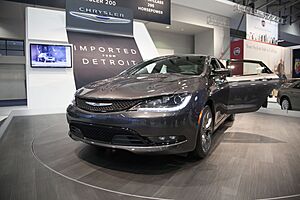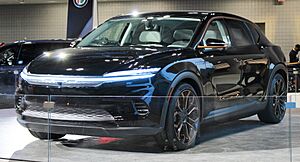Chrysler (brand) facts for kids
 |
|
| Owner | Stellantis |
|---|---|
| Introduced | June 6, 1925 |
| Related brands | Mopar, Dodge, Plymouth |
| Markets | Worldwide |
| Previous owners |
|
| Ambassador(s) | Chris Feull (Chrysler brand CEO) |
Chrysler is a famous American car brand. It is part of Stellantis North America. The company was started in 1925 by Walter Chrysler. He built it from what was left of the Maxwell Motor Company. Chrysler cars were known for being luxurious. The company grew by making different types of cars for different people, much like General Motors did.
Chrysler cars have always been popular. Even though other Stellantis brands have become more visible recently, many car fans still love Chrysler. As of 2025, Chrysler mainly makes the Pacifica minivan. However, Stellantis plans to bring back more Chrysler models. They showed a concept car called the Chrysler Airflow concept. This shows they want to use Chrysler's long history and popularity.
Contents
The Story of Chrysler Cars
How Chrysler Began
The very first Chrysler cars were shown on January 5, 1924. This was a year before the Chrysler Corporation officially started. These early cars, made by Maxwell Motors, had new features. They included a powerful six-cylinder engine and special brakes on all four wheels. These features were new for cars that weren't super expensive. People loved them, and 32,000 cars were sold in the first year.
In 1926, Chrysler introduced the Chrysler 70. It was named because it could go 70 miles per hour. By 1927, Chrysler had four different models. These were the Chrysler 50, 60, 70, and the fancy Imperial 80. Chrysler was the fourth best-selling car brand that year. In 1928, Chrysler spent $23 million to make its factories bigger.
Chrysler in the 1930s
In the 1930s, Chrysler added new features to its cars. In 1930, some models were ready for radios. Chrysler also became the first car company to use a special type of carburetor. This helped the engine work better. In 1932, Chrysler cars got "Floating Power" engine mounts. These were made of rubber and helped stop vibrations. This made the ride much smoother.
In 1934, Chrysler introduced the revolutionary Chrysler Airflow. This car had a special body designed to cut through the wind. This made it handle better and use less power. It was a very modern design for its time. In 1935, Chrysler also offered the Chrysler Airstream Six. This car was more affordable and looked more traditional than the Airflow.
By 1937, most Airflow cars were stopped. Chrysler focused on models like the Royal and Imperial. These cars had special rubber mounts to reduce road vibrations. In 1939, Chrysler introduced "Superfinish." This made car parts very smooth, helping them last longer. They also added new push-button door locks.
Chrysler in the 1940s
In 1940, Chrysler cars got sealed beam headlights. These lights made it 50% easier to see at night. Chrysler also added special editions like the Highlander. This model had a unique Scottish plaid interior. The luxury Saratoga model was also added.
In 1941, Chrysler introduced the Fluid Drive transmission. This was a semi-automatic gearbox. In 1942, Chrysler cars were redesigned with a new chrome grille. However, car production for civilians stopped in February 1942 because of World War II. After the war, in 1946, Chrysler brought back the Town & Country car. In 1949, Chrysler released completely new car designs. They also brought back the nine-passenger station wagon.
Chrysler in the 1950s
In 1950, Chrysler updated its car designs. They made cars slightly lower and simplified the grilles. They also added disc brakes to the Imperial model. The new Chrysler Newport hardtop and power windows were also introduced. Chrysler's first V8 engine came out in 1951. It was very powerful for its time. This engine was special because it had "hemispherical combustion chambers."
Chrysler also made a unique sports car in 1955. It was based on the New Yorker coupe. This car had a powerful "Hemi" V8 engine. It was called the Chrysler 300. The name highlighted its 300 horsepower. This car was a luxury sports model.
In 1955, the fancy Imperial became its own separate luxury car brand. It was even more upscale than Chrysler. Imperial remained a separate brand until 1975. It came back as a Chrysler model from 1990 to 1993.
A new design by Virgil Exner in 1955 greatly increased Chrysler sales. Sales went up even more in 1957 with another big redesign. These cars had a sloped front and large tailfins. However, there were some quality problems at first. In 1957, all Chrysler cars got a new front suspension system.
Sales dropped in 1958 and 1959, even with better quality. Chrysler models in the 1950s included the New Yorker, Saratoga, and Windsor. Exner's designs in the early 1960s were too exaggerated. He left in 1962, and Elwood Engel took over Chrysler styling.
Chrysler in the 1960s
In 1963, Chrysler introduced a new, cleaner, and boxier car design. The Newport model replaced the Desoto, Windsor, and Saratoga lines. The New Yorker continued as the luxury model. The Imperial remained the top-of-the-line brand. The Chrysler 300 continued as a high-performance coupe.
In 1965, Chrysler cars were redesigned again. They had a modern "unit body" construction. This meant the body and frame were one piece. They also had larger engines. These cars were known for being well-built and having innovative features.
In 1963, Chrysler introduced the Chrysler Turbine Car. This was an experimental car powered by a special turbine engine. It was a two-door coupe. Only 55 of these unique cars were made between 1963 and 1964.
Chrysler in the 1970s
The Cordoba was introduced in 1975. It was a fancy personal luxury car. It competed with cars like the Oldsmobile Cutlass. The Cordoba was originally planned to be a Plymouth car. But after some financial difficulties, Chrysler decided to sell it under the more upscale Chrysler brand. This was to make more profit.
The Cordoba was a big success. Over 150,000 were sold in 1975. Sales increased even more in 1976. The car's success showed that using the Chrysler nameplate was a good idea. The Cordoba had very luxurious interiors. They often featured soft velour seats or special leather.
In 1977, Chrysler launched a new line of mid-size cars called LeBaron. This line included a coupe, sedan, and station wagon.
Chrysler in the 1980s
In 1982, the LeBaron became a smaller, front-wheel-drive car. It was Chrysler's most affordable car. It was available as a sedan and coupe. In early 1982, a convertible version was released. This was the first factory-built open-top American car since 1976. A station wagon version, called the Town and Country, was also added. A special Town and Country convertible was made in small numbers from 1983 to 1986. It had fake wood panels, like the original 1940s model.
Also in 1982, the New Yorker name was moved to a smaller car. The fancy Fifth Avenue option was still available. It included a special vinyl roof and luxurious seats. These seats were covered in soft velvet or leather. The Fifth Avenue also had thicker carpet and more chrome inside.
The last year for Chrysler's Cordoba coupe was 1983. That year, Chrysler introduced a new front-wheel-drive New Yorker. It was based on a stretched K-Car platform. A less expensive version was sold as the Chrysler E-Class. More upscale stretched K-Car models were sold as Chrysler Executive sedans and limousines.
From 1984, the New Yorker Fifth Avenue was simply called Fifth Avenue. This name continued for six successful years. These cars were powered by a V8 engine. Fifth Avenue production moved to different plants over the years. The Fifth Avenue sold much better than its Dodge and Plymouth cousins. It was Chrysler's only traditional rear-wheel-drive sedan.
In 1985, Chrysler introduced a new mid-size four-door hatchback called the LeBaron GTS. The LeBaron coupe and convertible were redesigned in 1987. These new models had unique styling. They featured hidden headlights and full-width taillights.
The New Yorker was redesigned in 1988. It now came with a V6 engine as standard. This New Yorker also brought back hidden headlights. In 1989, Chrysler released the TC by Maserati. This was a luxury roadster made with Maserati.
Chrysler in the 1990s
In 1989, Chrysler brought back the Town & Country name for a luxury minivan. It was a fancy version of the Dodge Grand Caravan. This minivan was sold until 2016. Then, Chrysler reintroduced the Pacifica name for its minivan.
In 1990, Fifth Avenue became a model of the New Yorker again. The New Yorker Fifth Avenue used a slightly longer chassis. This made its interior larger. It was classified as a full-size car. Chrysler's new 3.3L V6 engine was standard. Later, a larger 3.8L V6 became optional.
The New Yorker Fifth Avenue kept its famous, comfortable seats. They were available in velour or leather. The leather seats had the Mark Cross logo. The New Yorker Fifth Avenue got a new, more rounded design in 1992.
The early 1990s saw the Imperial return as a high-end sedan. This time, it was a model of Chrysler, not a separate brand. It was the top full-size car in Chrysler's lineup. The Imperial looked different from the New Yorker Fifth Avenue. It had a more wedge-shaped front and rounded rear. It also featured full-width taillights.
The 1990 Imperial had a 3.3L V6 engine. In 1991, it was replaced by a larger 3.8L V6. Both engines came with a four-speed automatic transmission.
Also new for 1990 was a redesigned LeBaron sedan. It offered a standard V6 engine. Later models also had 4-cylinder engines. The Town & Country minivan was restyled in 1991. This was also the last year for the TC by Maserati.
The first Chrysler Concorde was shown in 1992 as a 1993 model. It was a well-equipped car. The Concorde had a modern version of Chrysler's waterfall grille. Its rear had a full-width lightbar between the taillights. This made the taillights look like they stretched across the whole trunk.
In 1993, the Chrysler LHS was introduced. It was the top-of-the-line model for Chrysler. It shared its platform with other LH-series cars. The LHS was different from the New Yorker sedan. It had leather bucket seats and a sportier look. The New Yorker was stopped after 1996.
The final New Yorker generation was released in 1993 as an early 1994 model. It was a front-wheel-drive car. The New Yorker came with a 3.5L V6 engine. Chrysler gave the New Yorker a "traditional American" luxury image. The LHS had a more "European performance" image. The New Yorker had chrome trim and a front bench seat.
In 1995, the Chrysler Sebring coupe was introduced. It replaced the LeBaron coupe. The new Chrysler Cirrus replaced the LeBaron sedan. A year later, a convertible version of the Sebring came out. In 1999, Chrysler introduced the new 300M sedan. It was originally planned to be an Eagle Vision. But since the Eagle brand was stopped, it became a Chrysler car.
Chrysler in the 2000s
In 2000, the Voyager and Grand Voyager minivans became Chrysler models. This happened because the Plymouth brand was being phased out. In 2001, a sedan was added to the Sebring line. It replaced the Cirrus. That same year, Chrysler added the retro-styled PT Cruiser. They also added the Prowler roadster. By 2004, all Chrysler minivans were sold as the Town & Country.
The 2000s also saw Chrysler enter the crossover and SUV market. They introduced the Chrysler Pacifica crossover in 2004. The Chrysler Aspen SUV followed in 2007. The Pacifica crossover was stopped in 2008. The Aspen SUV was stopped in 2009. The Pacifica name returned on a new minivan in 2017.
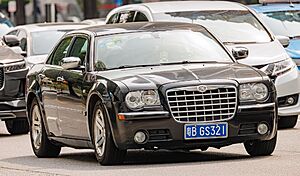
Between 2004 and 2008, Chrysler offered a two-seat coupe and convertible called Crossfire. In 2005, Chrysler introduced the LX platform Chrysler 300 sedan. This car replaced both the 300M and Concorde. It was Chrysler's first rear-wheel-drive sedan since 1989. It was also the first time a Chrysler sedan had a V8 engine since 1989.
Chrysler in the 2010s
Chrysler Corporation started working with the Italian carmaker Fiat. This led to the two companies merging in 2014. The new company, Fiat Chrysler Automobiles (FCA), wanted to make Chrysler a full luxury brand again. They hoped to compete with brands like Cadillac. However, these plans did not fully happen during this decade.
In 2011, Chrysler's winged logo was changed. The historic blue ribbon was removed. The Chrysler 300 was restyled that year. The Sebring was renamed the Chrysler 200. In 2014, FCA announced Chrysler would be a mainstream brand with premium features. A redesigned Chrysler 200 was introduced for 2015. But it was stopped in 2017. FCA decided to focus more on SUVs and minivans. In 2017, the Chrysler Pacifica name returned on a new minivan. It replaced the long-running Town & Country.
During this time, Chrysler's quality ratings were sometimes below average. However, the quality of all cars was improving. So, the difference between high and low ratings was becoming smaller.
Chrysler in the 2020s
In the early 2020s, Chrysler had only two car models. These were the Chrysler Pacifica minivan and the Chrysler 300 sedan. The 300 sedan was last redesigned in 2010. In March 2023, Stellantis CEO Carlos Tavares said the brand would be "relaunched." This means new models are coming. One new model is expected to be an electric crossover SUV by 2025. This was shown by the Chrysler Airflow concept car. In December 2023, the Chrysler 300 was stopped. The company plans to make the Chrysler brand fully electric by 2028.
Current Chrysler Vehicles
As of 2025, Chrysler's main vehicles are the Chrysler Pacifica minivan and its related model, the Chrysler Voyager.



